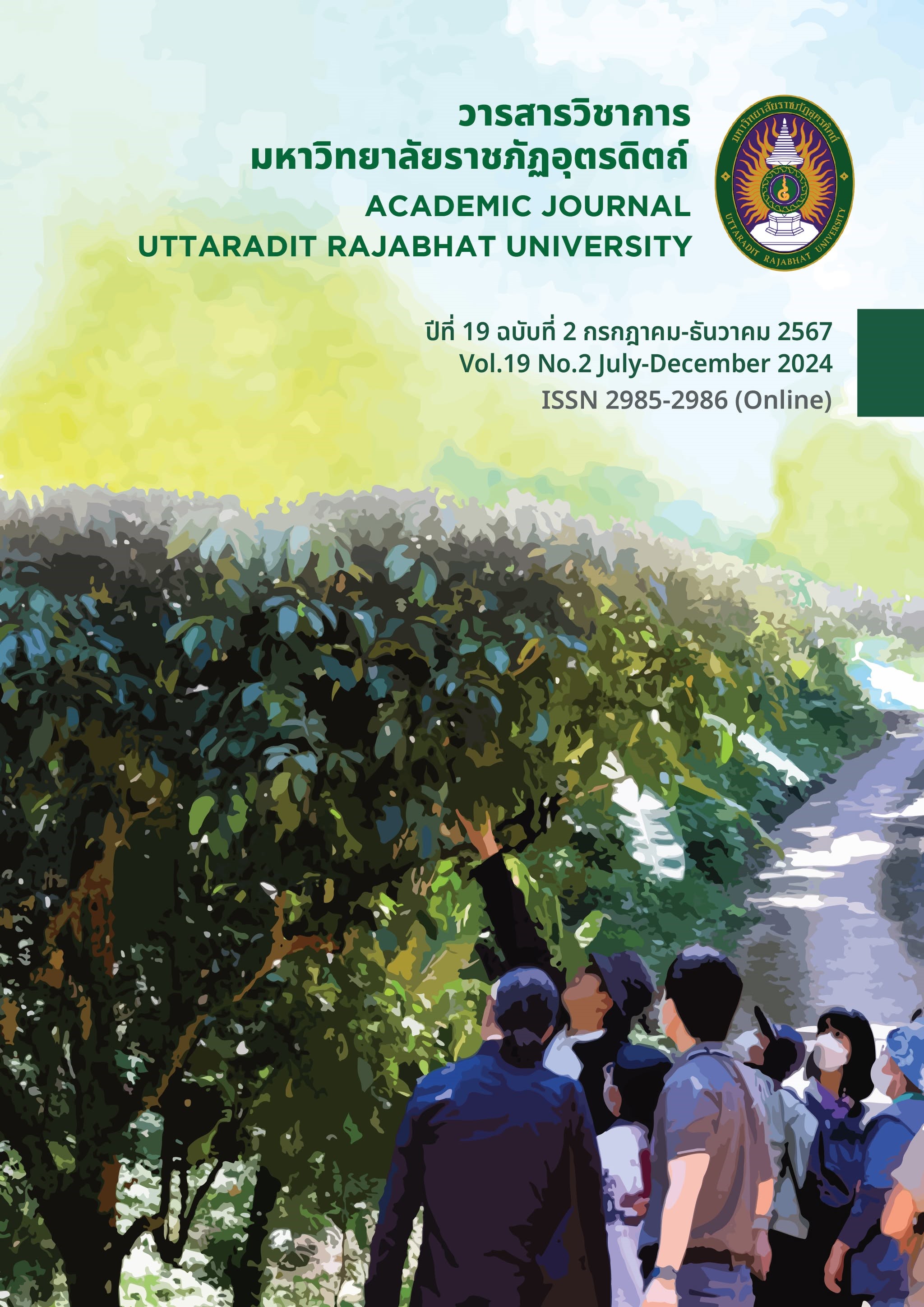DEVELOPMENT OF BODY AND GLAZES SANGKHALOK FROM THE MIXTUREOF COLORED GLASS BOTTLES FOR THE PRODUCTION OF DECORATIVE TILES TO COMMERCIAL DISTRIBUTION BY THE WISDOM OF THE SANGKHALOK SUKHOTHAI PROVICE
Main Article Content
Abstract
The objectives of this research were to experiment with the composition and test the physical properties of clay and glaze in Sangkhalok ceramics using colored glass bottle mixtures to produce decorative building tiles incorporating colored glass bottles, and evaluate the satisfaction of 50 consumers with the decorative building tile products. The raw materials used for testing were soil from Khao See Larn Mountain, top-layer soil, and Green Glass Bottles. While, the raw materials used for the coating experiment were soil from Khao See Larn Mountain, feldspar, limestone, and green glass bottles. The experiments of both soil testing and coating mixtures were fired at a temperature of 1,220 degrees Celsius in a complete incineration atmosphere. Tile product patterns were designed in collaboration with entrepreneurs using the Sangkhalok’s identity as a concept. Subsequently, the selection process involved choosing 10 prototype patterns which were then formed into tile samples for evaluation of consumer satisfaction. The research results indicated that the soil mixture with physical properties suitable for tile production was Formula No.3, and the coating formula suitable was Formula No. 1. To elaborate on, the soil mixture Formula No.3 consisted of 70% of soil from Khao See Larn Mountain, 20% of top-layer soil, and 10% of green glass bottles. Additionally, the average shrinkage of this formula was 7.79%, the average strength was 184.14 kilograms per square centimeter, the average water absorption was 1.34%, and the soil was heat-resistant at a temperature of 1,220 degrees Celsius and it had a color of brown. On the other hand, the coating Formula No. 1, consisted of 75% of green glass bottles, 5% of limestone, 20% of feldspar, and 3% of additional soil from Khao See Larn Mountain. The coating had a translucent appearance, smooth surface, clear green color, and flow rate of 4.67 centimeters. The tile design was inspired by the fish patterns and floral motifs of Sangkhalok, which were distinctive cultural features of Sukhothai Province. These elements were adapted into the surface design of all 10 tile prototypes. In addition, the overall satisfaction rating for the tiles exceeded 4.22±0.19, indicating a high level of satisfaction. The researcher transferred knowledge on using green glass bottle waste from the community as a raw material for Sangkhalok ceramic production to local manufacturers in Sukhothai Province. This research had the potential to reduce production costs for the manufacturers.
Downloads
Article Details

This work is licensed under a Creative Commons Attribution-NonCommercial-NoDerivatives 4.0 International License.
References
กรมวิทยาศาสตร์บริการ. (2563). ความรู้ทั่วไปด้านแก้ว. http://otop.dss.go.th/index.php/en/knowledge/interesting-articles/136-2017-05-31-06-33-45
โกมล รักษ์วงศ์. (2531). วัตถุดิบที่ใช้ในงานเครื่องปั้นดินเผาและเนื้อดินปั้น. วิทยาลัยครูพระนคร.
ธนสิทธิ์ จันทะรี. (2552). เครื่องปั้นดินเผาขั้นพื้นฐาน. มหาวิทยาลัยขอนแก่น.
นิดดา หงษ์วิวัฒน์. (2554). เครื่องปั้นดินเผา. คติ.
ปรีดา พิมพ์ขาวขำ. (2539). เซรามิกส์ (พิมพ์ครั้งที่ 4). โรงพิมพ์จุฬาลงกรณ์มหาวิทยาลัย.
ปุณณรัตน์ พิชญไพบูลย์. (2538). เครื่องเคลือบดินเผาเทคนิคและวิธีการสร้างสรรค์. โรงพิมพ์จุฬาลงกรณ์มหาวิทยาลัย.
ไพจิตร อิ่งศิริวัฒน์. (2541). เนื้อดินเซรามิก. โอเดียนสโตร์.
ไพบูลย์ หน้าสมศรี. (2552). เคลือบสีแดงของทองแดง. โอเดียนสโตร์.
ภุชชงค์ จันทวิช. (2551). เครื่องถ้วยในประเทศไทย “เครื่องถ้วยเบญจรงค์”. เมืองโบราณ.
สุขุมาล เล็กสวัสดิ์. (2548). เครื่องปั้นดินเผา พื้นฐานการออกแบบและปฏิบัติงาน. สำนักพิมพ์จุฬาลงกรณ์มหาวิทยาลัย.
สุรศักดิ์ โกสิยพันธ์. (2534). น้ำเคลือบเครื่องปั้นดินเผา. ไทยวัฒนาพานิช.
ปวิตา ลิขิตเดชาโรจน์. (2565, 18 กุมภาพันธ์). แก้ว. องค์การพิพิธภัณฑ์วิทยาศาสตร์แห่งชาติ. https://www.nsm.or.th/nsm/th/node/9948
Andrews, A. I. (1928). Ceramic test and calculation. John Milley and Sons.
Rhodes, Danial. (1973). Clay and Glazes for the Potter. Chilton Book.


